RENAULT KANGOO 2016 X61 / 2.G Owner's Guide
Manufacturer: RENAULT, Model Year: 2016, Model line: KANGOO, Model: RENAULT KANGOO 2016 X61 / 2.GPages: 173, PDF Size: 3.8 MB
Page 31 of 173
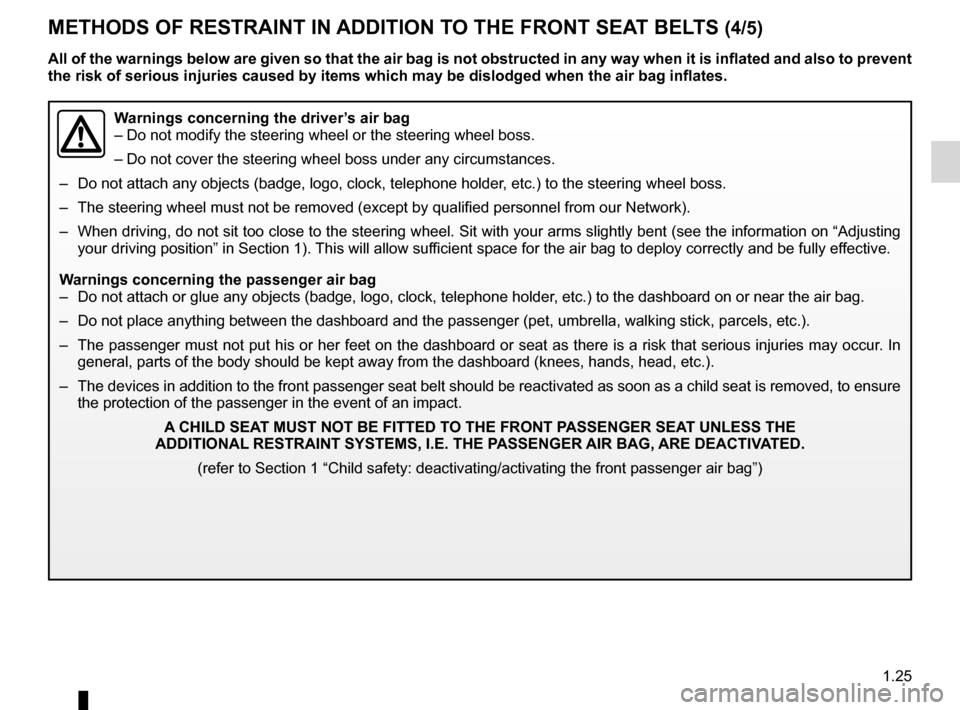
JauneNoirNoir texte
1.25
ENG_UD14673_2
Dispositifs complémentaires à la ceinture avant (X76 - Renault)
ENG_NU_854-2_X76LL_Renault_1
METHODS OF RESTRAINT IN ADDITION TO THE FRONT SEAT BELTS (4/5)
All of the warnings below are given so that the air bag is not obstructed in any way when it is inflated and also to prevent
the risk of serious injuries caused by items which may be dislodged when\
the air bag inflates.
Warnings concerning the driver’s air bag
– Do not modify the steering wheel or the steering wheel boss.
– Do not cover the steering wheel boss under any circumstances.
– Do not attach any objects (badge, logo, clock, telephone holder, etc.) to the steering wheel boss.
– The steering wheel must not be removed (except by qualified personnel from our Network).
– When driving, do not sit too close to the steering wheel. Sit with your arms slightly bent (see the information on “Adjusting
your driving position” in Section 1). This will allow sufficient space for the air bag to deploy correctly and be fully effective.
Warnings concerning the passenger air bag
–
Do not attach or glue any objects (badge, logo, clock, telephone holder, etc.) to the dashboard on or near the air bag.
– Do not place anything between the dashboard and the passenger (pet, umbrella, walking stick, parcels, etc.).
– The passenger must not put his or her feet on the dashboard or seat as there is a risk that serious injuries may occur. In
general, parts of the body should be kept away from the dashboard (knee\
s, hands, head, etc.).
–
The devices in addition to the front passenger seat belt should be reactivated as soon as a child seat is removed, to ensure
the protection of the passenger in the event of an impact.
A CHILD SEAT MUST NOT BE FITTED TO THE FRONT PASSENGER SEAT UNLESS THE
ADDITIONAL
RESTRAINT SYSTEMS, I.E. THE PASSENGER AIR BAG, ARE DEACTIv ATED.
(refer to Section 1 “Child safety: deactivating/activating the front\
passenger air bag”)
Page 32 of 173
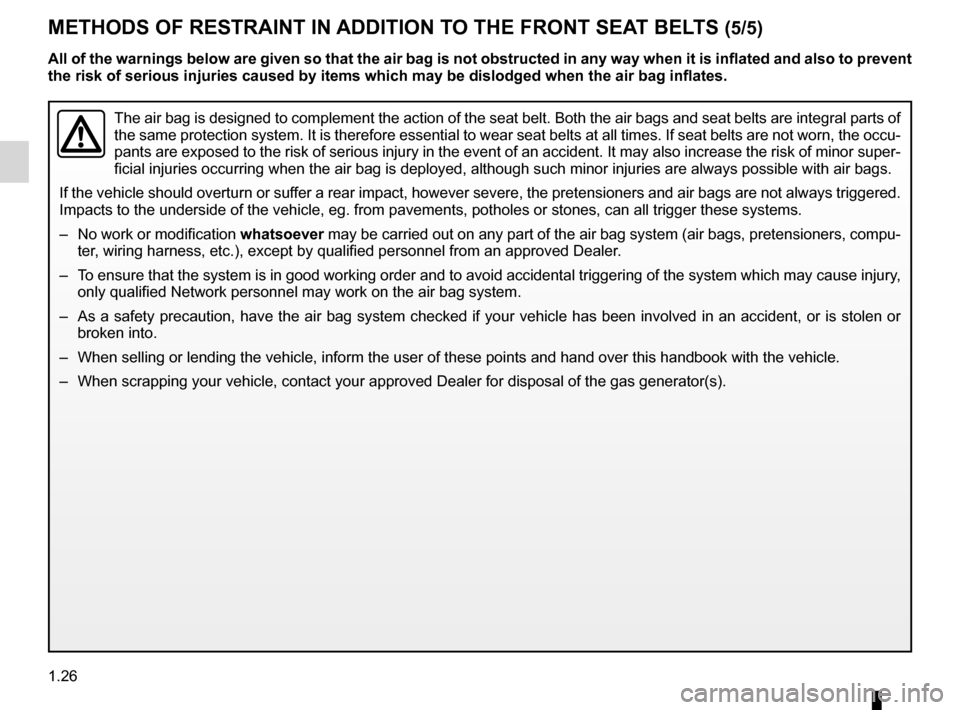
1.26
ENG_UD14673_2
Dispositifs complémentaires à la ceinture avant (X76 - Renault)
ENG_NU_854-2_X76LL_Renault_1
The air bag is designed to complement the action of the seat belt. Both the air bags and seat belts are integral parts of
the same protection system. It is therefore essential to wear seat belts at all times. If seat belts are not worn, the occu-
pants are exposed to the risk of serious injury in the event of an accident. It may also increase the risk of minor super-
ficial injuries occurring when the air bag is deployed, although such mi\
nor injuries are always possible with air bags.
If the vehicle should overturn or suffer a rear impact, however severe, the pretensioners and air bags are not always triggered.
Impacts to the underside of the vehicle, eg. from pavements, potholes or\
stones, can all trigger these systems.
–
No work or modification whatsoever may be carried out on any part of the air bag system (air bags, pretensioners, compu-
ter, wiring harness, etc.), except by qualified personnel from an approved\
Dealer.
–
To ensure that the system is in good working order and to avoid accidental triggering of the system which may cause injury,
only qualified Network personnel may work on the air bag system.
–
As a safety precaution, have the air bag system checked if your vehicle has been involved in an accident, or is stolen or
broken into.
–
When selling or lending the vehicle, inform the user of these points and hand over this handbook with the vehicle.
– When scrapping your vehicle, contact your approved Dealer for disposal of the gas generator(s).
All of the warnings below are given so that the air bag is not obstructed in any way when it is inflated and also to prevent
the risk of serious injuries caused by items which may be dislodged when\
the air bag inflates.
METHODS OF RESTRAINT IN ADDITION TO THE FRONT SEAT BELTS (5/5)
Page 33 of 173
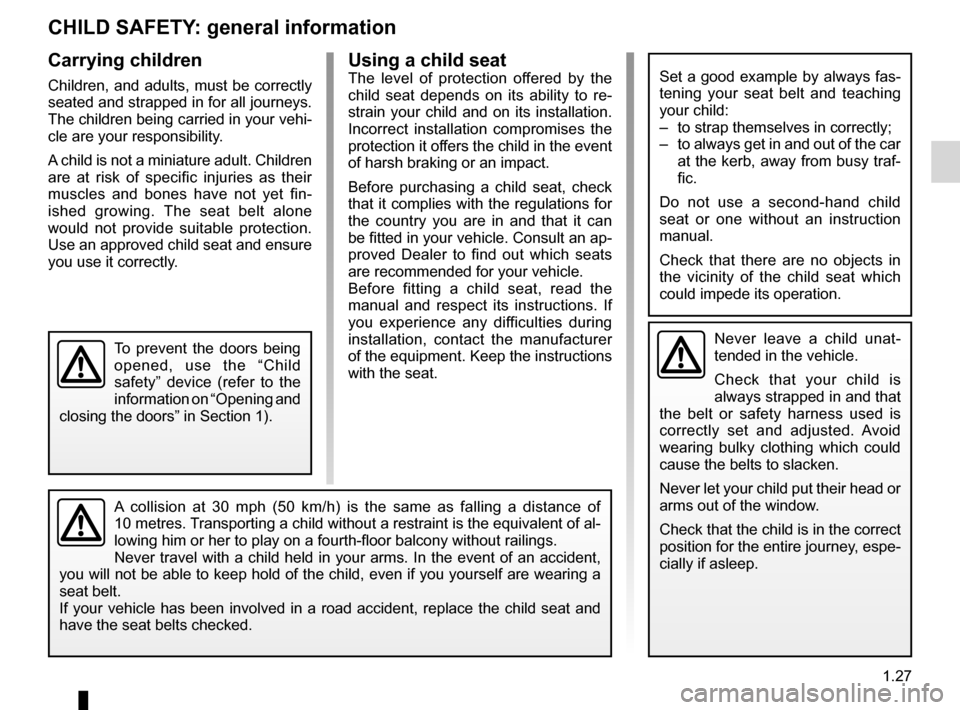
child restraint/seat ................................ (up to the end of the DU)
children ................................................. (up to the end of the DU)
child restraint/seat ................................ (up to the end of the DU)
child safety............................................ (up to the end of the DU)
child restraint/seat ................................ (up to the end of the DU)
transporting children ............................. (up to the end of the DU) 1.27
ENG_UD7697_1
Sécurité enfants : généralités (X76 - Renault)
ENG_NU_854-2_X76LL_Renault_1
Child safety: General information
CHILD SAFETY : general information
Carrying children
Children, and adults, must be correctly
seated and strapped in for all journeys.
The children being carried in your vehi-
cle are your responsibility.
A child is not a miniature adult. Children
are at risk of specific injuries as their
muscles and bones have not yet fin-
ished growing. The seat belt alone
would not provide suitable protection.
Use an approved child seat and ensure
you use it correctly.
Never leave a child unat-
tended in the vehicle.
Check that your child is
always strapped in and that
the belt or safety harness used is
correctly set and adjusted. Avoid
wearing bulky clothing which could
cause the belts to slacken.
Never let your child put their head or
arms out of the window.
Check that the child is in the correct
position for the entire journey, espe-
cially if asleep.To prevent the doors being
opened, use the “Child
safety” device (refer to the
information on “Opening and
closing the doors” in Section
1).
Set a good example by always fas-
tening your seat belt and teaching
your child:
–
to strap themselves in correctly;
– to always get in and out of the car
at the kerb, away from busy traf-
fic.
Do not use a second-hand child
seat or one without an instruction
manual.
Check that there are no objects in
the vicinity of the child seat which
could impede its operation.
A collision at 30 mph (50 km/h) is the same as falling a distance of
10
metres. Transporting a child without a restraint is the equivalent of al -
lowing him or her to play on a fourth-floor balcony without railings.
Never travel with a child held in your arms. In the event of an accident,
you will not be able to keep hold of the child, even if you yourself are wearing a
seat belt.
If your vehicle has been involved in a road accident, replace the child seat and
have the seat belts checked.
Using a child seatThe level of protection offered by the
child seat depends on its ability to re-
strain your child and on its installation.
Incorrect installation compromises the
protection it offers the child in the event
of harsh braking or an impact.
Before purchasing a child seat, check
that it complies with the regulations for
the country you are in and that it can
be fitted in your vehicle. Consult an ap-
proved Dealer to find out which seats
are recommended for your vehicle.
Before fitting a child seat, read the
manual and respect its instructions. If
you experience any difficulties during
installation, contact the manufacturer
of the equipment. Keep the instructions
with the seat.
Page 34 of 173
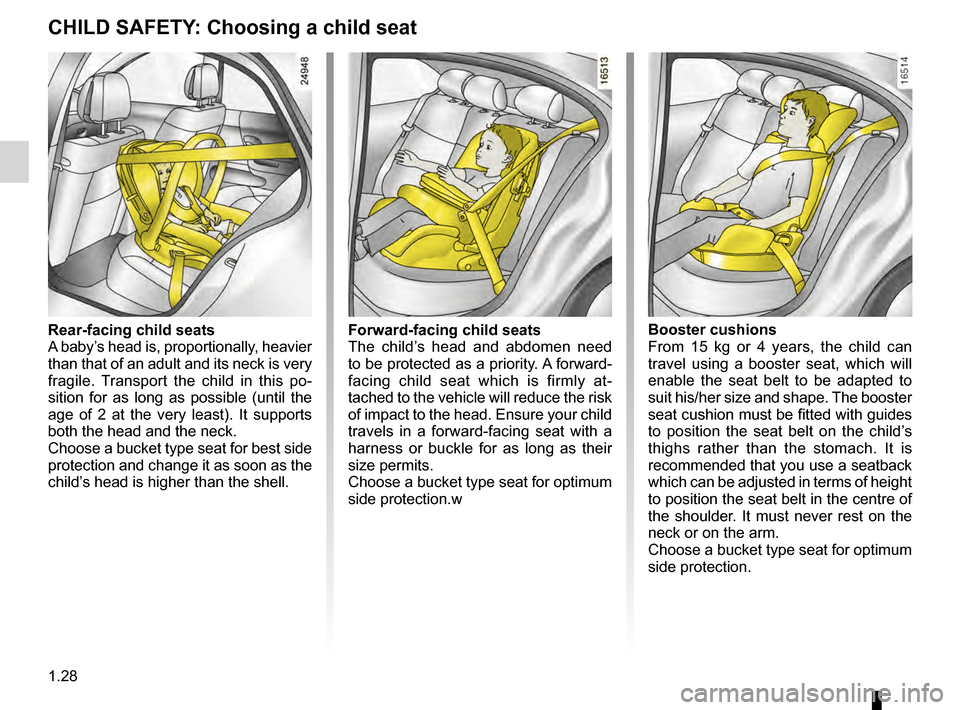
1.28
ENG_UD7697_1
Sécurité enfants : généralités (X76 - Renault)
ENG_NU_854-2_X76LL_Renault_1
CHILD SAFETY : Choosing a child seat
Rear-facing child seats
A baby’s head is, proportionally, heavier
than that of an adult and its neck is very
fragile. Transport the child in this po-
sition for as long as possible (until the
age of 2 at the very least). It supports
both the head and the neck.
Choose a bucket type seat for best side
protection and change it as soon as the
child’s head is higher than the shell.Forward-facing child seats
The child’s head and abdomen need
to be protected as a priority. A forward-
facing child seat which is firmly at-
tached to the vehicle will reduce the risk
of impact to the head. Ensure your child
travels in a forward-facing seat with a
harness or buckle for as long as their
size permits.
Choose a bucket type seat for optimum
side protection.w Booster cushions
From 15 kg or 4 years, the child can
travel using a booster seat, which will
enable the seat belt to be adapted to
suit his/her size and shape. The booster
seat cushion must be fitted with guides
to position the seat belt on the child’s
thighs rather than the stomach. It is
recommended that you use a seatback
which can be adjusted in terms of height
to position the seat belt in the centre of
the shoulder. It must never rest on the
neck or on the arm.
Choose a bucket type seat for optimum
side protection.
Page 35 of 173
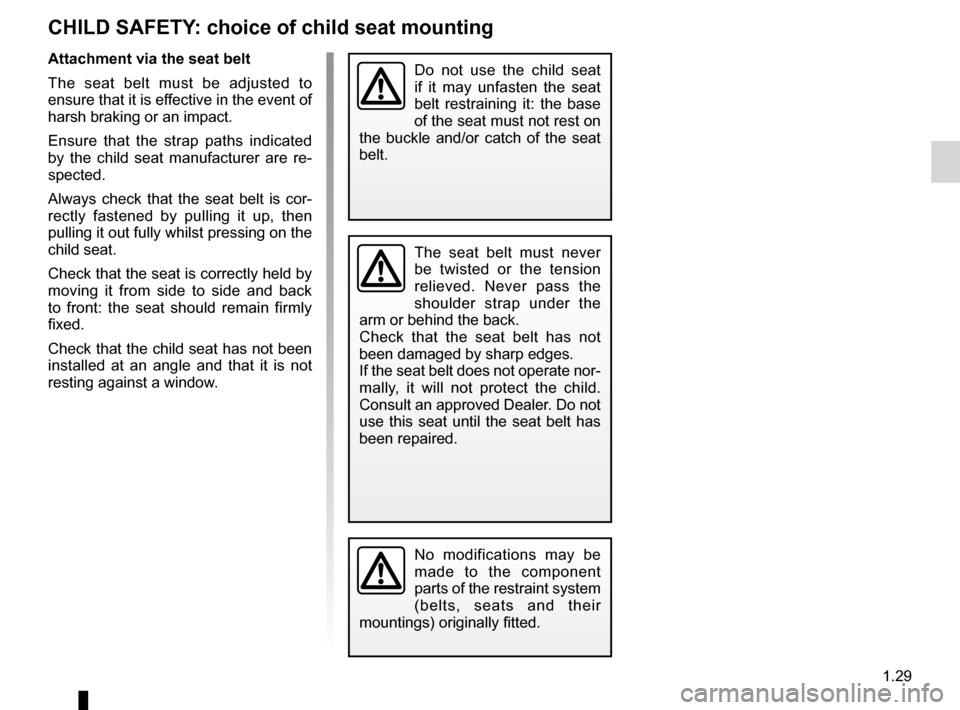
child safety............................................ (up to the end of the DU)
child restraint/seat ................................ (up to the end of the DU)
child seats............................................. (up to the end of the DU)
towing rings .......................................... (up to the end of the DU)
transporting children ............................. (up to the end of the DU)
child restraint/seat ................................ (up to the end of the DU) 1.29
ENG_UD7699_1
Sécurité enfants : choix du siège enfants (X76 - Renault)
ENG_NU_854-2_X76LL_Renault_1
Choosing a child seat mounting
CHILD SAFETY : choice of child seat mounting
Attachment via the seat belt
The seat belt must be adjusted to
ensure that it is effective in the event of
harsh braking or an impact.
Ensure that the strap paths indicated
by the child seat manufacturer are re-
spected.
Always check that the seat belt is cor-
rectly fastened by pulling it up, then
pulling it out fully whilst pressing on the
child seat.
Check that the seat is correctly held by
moving it from side to side and back
to front: the seat should remain firmly
fixed.
Check that the child seat has not been
installed at an angle and that it is not
resting against a window.
No modifications may be
made to the component
parts of the restraint system
(belts, seats and their
mountings) originally fitted.
The seat belt must never
be twisted or the tension
relieved. Never pass the
shoulder strap under the
arm or behind the back.
Check that the seat belt has not
been damaged by sharp edges.
If the seat belt does not operate nor-
mally, it will not protect the child.
Consult an approved Dealer. Do not
use this seat until the seat belt has
been repaired.
Do not use the child seat
if it may unfasten the seat
belt restraining it: the base
of the seat must not rest on
the buckle and/or catch of the seat
belt.
Page 36 of 173
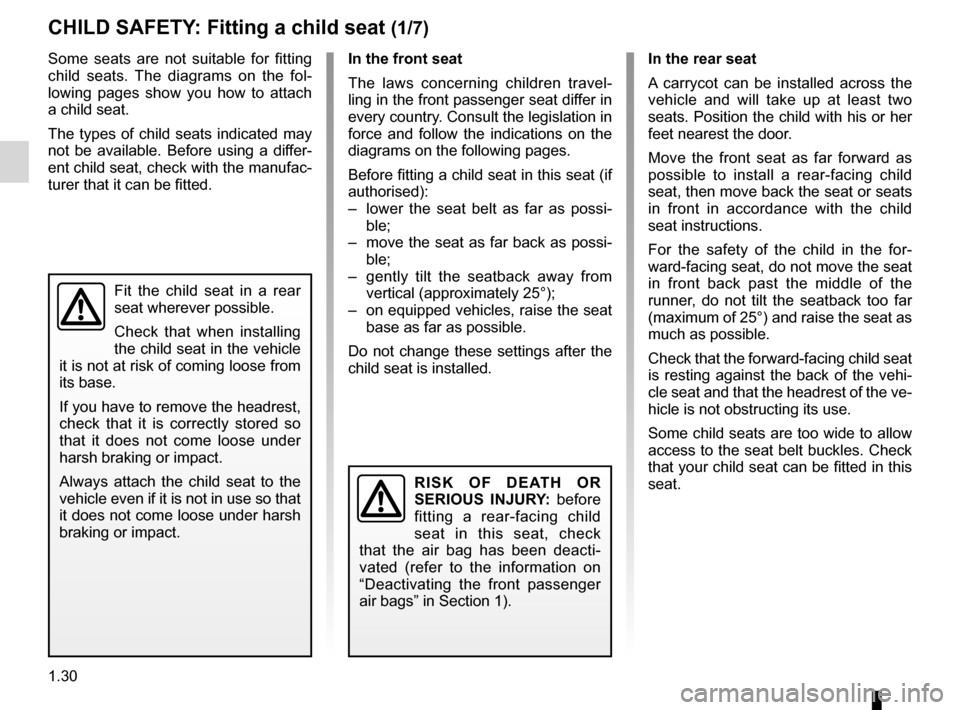
child restraint/seat ................................ (up to the end of the DU)
child restraint/seat ................................ (up to the end of the DU)
child restraint/seat ................................ (up to the end of the DU)
child safety............................................ (up to the end of the DU)
child seats............................................. (up to the end of the DU)
transporting children ............................. (up to the end of the DU)
1.30
ENG_UD14057_2
Sécurité enfants : installation du siège enfant (X76 - Renault\
)
ENG_NU_854-2_X76LL_Renault_1
Jaune NoirNoir texte
Fitting a child seat
CHILD SAFETY : Fitting a child seat (1/7)
Some seats are not suitable for fitting
child seats. The diagrams on the fol-
lowing pages show you how to attach
a child seat.
The types of child seats indicated may
not be available. Before using a differ-
ent child seat, check with the manufac-
turer that it can be fitted.
Fit the child seat in a rear
seat wherever possible.
Check that when installing
the child seat in the vehicle
it is not at risk of coming loose from
its base.
If you have to remove the headrest,
check that it is correctly stored so
that it does not come loose under
harsh braking or impact.
Always attach the child seat to the
vehicle even if it is not in use so that
it does not come loose under harsh
braking or impact.
In the front seat
The laws concerning children travel-
ling in the front passenger seat differ in
every country. Consult the legislation in
force and follow the indications on the
diagrams on the following pages.
Before fitting a child seat in this seat (if
authorised):
–
lower the seat belt as far as possi -
ble;
–
move the seat as far back as possi -
ble;
–
gently tilt the seatback away from
vertical (approximately 25°);
–
on equipped vehicles, raise the seat
base as far as possible.
Do not change these settings after the
child seat is installed. In the rear seat
A carrycot can be installed across the
vehicle and will take up at least two
seats. Position the child with his or her
feet nearest the door.
Move the front seat as far forward as
possible to install a rear-facing child
seat, then move back the seat or seats
in front in accordance with the child
seat instructions.
For the safety of the child in the for-
ward-facing seat, do not move the seat
in front back past the middle of the
runner, do not tilt the seatback too far
(maximum of 25°) and raise the seat as
much as possible.
Check that the forward-facing child seat
is resting against the back of the vehi-
cle seat and that the headrest of the ve-
hicle is not obstructing its use.
Some child seats are too wide to allow
access to the seat belt buckles. Check
that your child seat can be fitted in this
seat.
R I S K O F D E AT H O R
SERIOUS INJURY:
before
fitting a rear-facing child
seat in this seat, check
that the air bag has been deacti-
vated (refer to the information on
“Deactivating the front passenger
air bags” in Section 1).
Page 37 of 173
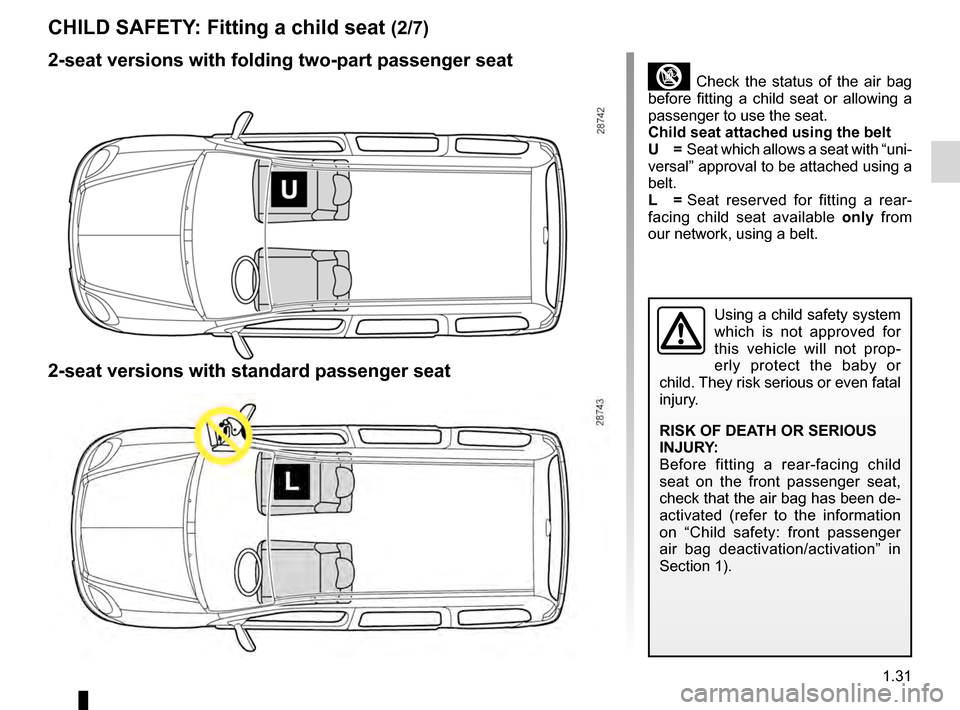
JauneNoirNoir texte
1.31
ENG_UD14057_2
Sécurité enfants : installation du siège enfant (X76 - Renault\
)
ENG_NU_854-2_X76LL_Renault_1
CHILD SAFETY : Fitting a child seat (2/7)
³ Check the status of the air bag
before fitting a child seat or allowing a
passenger to use the seat.
Child seat attached using the belt
U
= Seat which allows a seat with “uni -
versal” approval to be attached using a
belt.
L = S
eat reserved for fitting a rear -
facing child seat available only from
our network, using a belt.
2-seat versions with folding two-part passenger seat
2-seat versions with standard passenger seat
Using a child safety system
which is not approved for
this vehicle will not prop-
erly protect the baby or
child. They risk serious or even fatal
injury.
RISK OF DEATH OR SERIOUS
INJURY:
Before fitting a rear-facing child
seat on the front passenger seat,
check that the air bag has been de-
activated (refer to the information
on “Child safety: front passenger
air bag deactivation/activation” in
Section 1).
Page 38 of 173
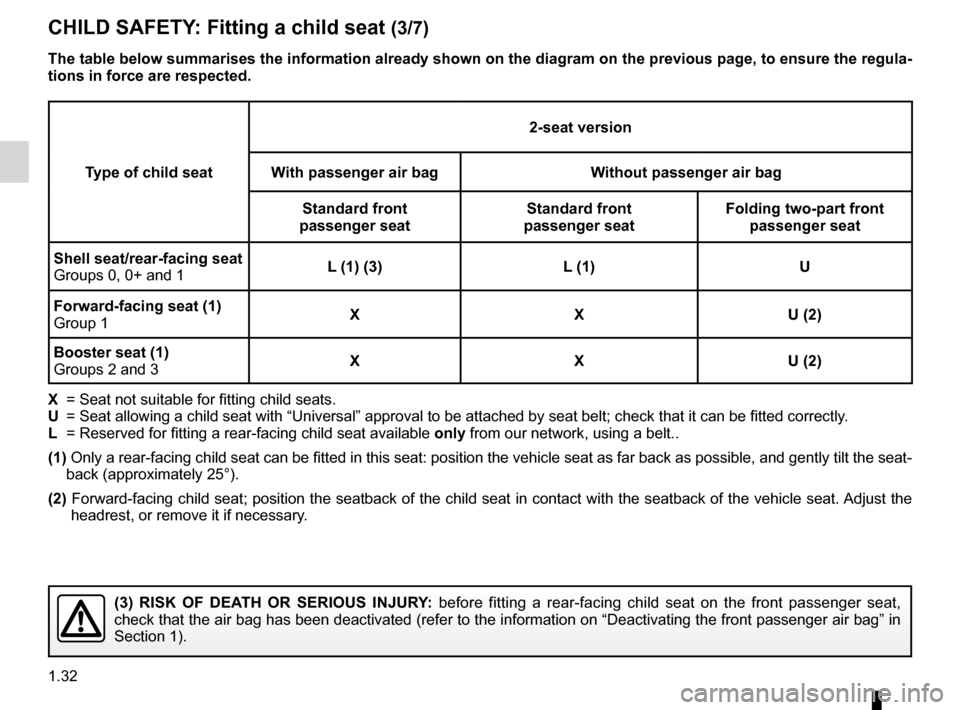
1.32
ENG_UD14057_2
Sécurité enfants : installation du siège enfant (X76 - Renault\
)
ENG_NU_854-2_X76LL_Renault_1
Jaune NoirNoir texte
Type of child seat 2-seat version
With passenger air bag Without passenger air bag
Standard front
passenger seat Standard front
passenger seat Folding two-part front
passenger seat
Shell seat/rear-facing seat
Groups 0, 0+ and 1 L (1) (3)
L (1) U
Forward-facing seat (1)
Group 1 X
XU (2)
Booster seat (1)
Groups 2 and 3 X
XU (2)
X =
Seat not suitable for fitting child seats.
U = Seat allowing a child seat with “Universal” approval to be attached by seat belt; check that it can be fitted correctly.
L = Reserved for fitting a rear-facing child seat available only from our network, using a belt..
(1) Only a rear-facing child seat can be fitted in this seat: position the vehicle seat as far back as possible, and gently tilt the seat- back (approximately 25°).
(2) Forward-facing
child seat; position the seatback of the child seat in contact with the seatback of the vehicle seat. Adjust the
headrest, or remove it if necessary.
CHILD SAFETY : Fitting a child seat (3/7)
The table below summarises the information already shown on the diagram on the previous page, to ensure the regula-
tions in force are respected.
(3) RISK OF DEATH OR SERIOUS INJURY: before fitting a rear-facing child seat on the front passenger seat,
check that the air bag has been deactivated (refer to the information on “Deactivating the front passenger air bag” in
Section
1).
Page 39 of 173
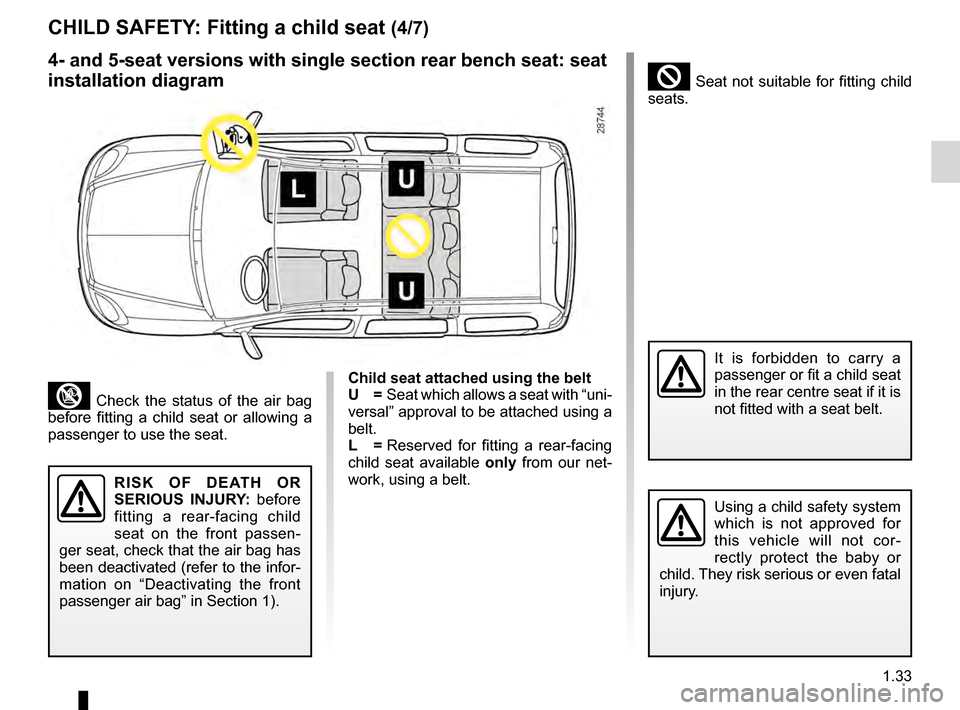
JauneNoirNoir texte
1.33
ENG_UD14057_2
Sécurité enfants : installation du siège enfant (X76 - Renault\
)
ENG_NU_854-2_X76LL_Renault_1
³ Check the status of the air bag
before fitting a child seat or allowing a
passenger to use the seat.
4- and 5-seat versions with single section rear bench seat: seat
installation diagram
CHILD SAFETY : Fitting a child seat (4/7)
Child seat attached using the belt
U = Seat which allows a seat with “uni -
versal” approval to be attached using a
belt.
L = Reserved for fitting a rear-facing
child seat available only from our net-
work, using a belt.
Using a child safety system
which is not approved for
this vehicle will not cor-
rectly protect the baby or
child. They risk serious or even fatal
injury.
R I S K O F D E AT H O R
SERIOUS INJURY: before
fitting a rear-facing child
seat on the front passen-
ger seat, check that the air bag has
been deactivated (refer to the infor-
mation on “Deactivating the front
passenger air bag” in Section 1).
It is forbidden to carry a
passenger or fit a child seat
in the rear centre seat if it is
not fitted with a seat belt.
² Seat not suitable for fitting child
seats.
Page 40 of 173
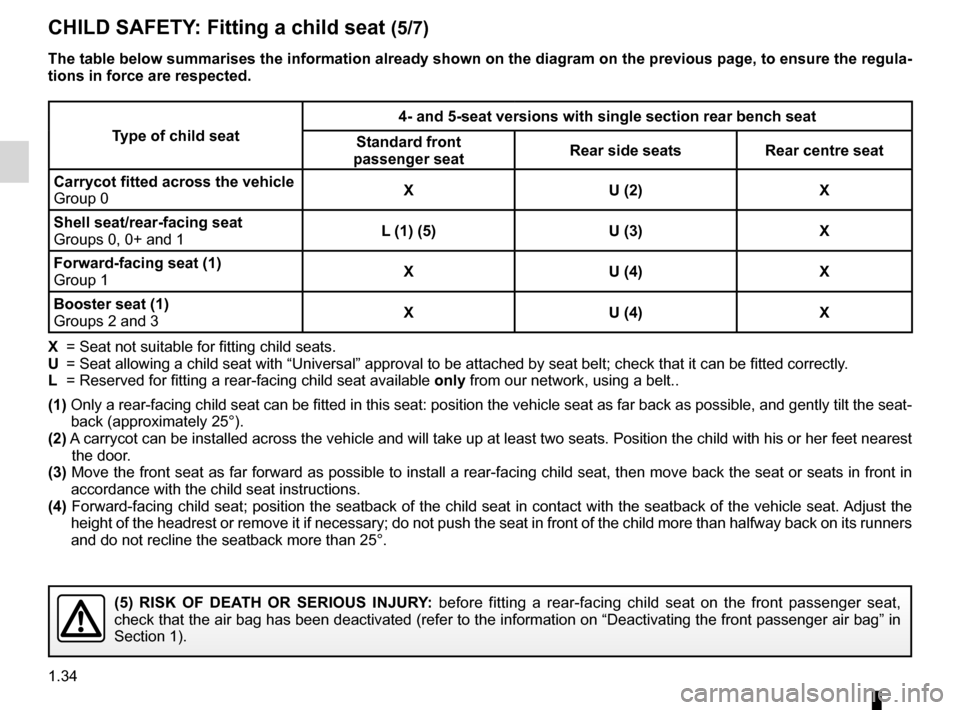
1.34
ENG_UD14057_2
Sécurité enfants : installation du siège enfant (X76 - Renault\
)
ENG_NU_854-2_X76LL_Renault_1
Jaune NoirNoir texte
CHILD SAFETY : Fitting a child seat (5/7)
The table below summarises the information already shown on the diagram on the previous page, to ensure the regula-
tions in force are respected.
(5) RISK OF DEATH OR SERIOUS INJURY: before fitting a rear-facing child seat on the front passenger seat,
check that the air bag has been deactivated (refer to the information on “Deactivating the front passenger air bag” in
Section
1).
Type of child seat 4- and 5-seat versions with single section rear bench seat
Standard front
passenger seat Rear side seats
Rear centre seat
Carrycot fitted across the vehicle
Group 0 X
U (2) X
Shell seat/rear-facing seat
Groups 0, 0+ and 1 L (1) (5)
U (3)X
Forward-facing seat (1)
Group 1 X
U (4) X
Booster seat (1)
Groups 2 and 3 X
U (4) X
X =
Seat not suitable for fitting child seats.
U = Seat allowing a child seat with “Universal” approval to be attached by seat belt; check that it can be fitted correctly.
L = Reserved for fitting a rear-facing child seat available only from our network, using a belt..
(1) Only
a rear-facing child seat can be fitted in this seat: position the vehicle seat as far back as possible, and gently tilt the seat-
back (approximately 25°).
(2)
A
carrycot can be installed across the vehicle and will take up at least two seats. Position the child with his or her feet nearest
the door.
(3) Move
the front seat as far forward as possible to install a rear-facing child seat, then move back the seat or seats in front in
accordance with the child seat instructions.
(4) Forward-facing
child seat; position the seatback of the child seat in contact with the seatback of the vehicle seat. Adjust the
height of the headrest or remove it if necessary; do not push the seat in front of the child more than halfway back on its runners
and do not recline the seatback more than 25°.